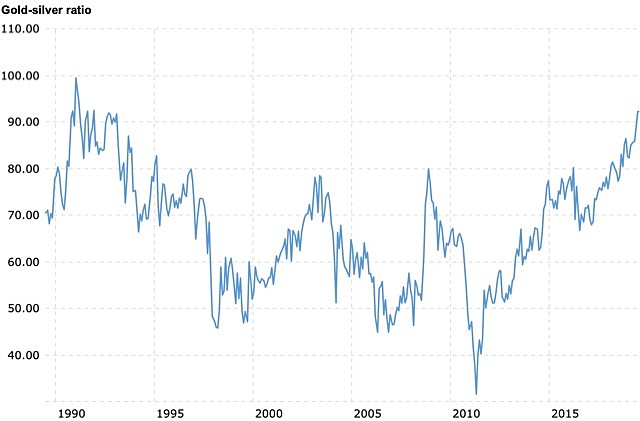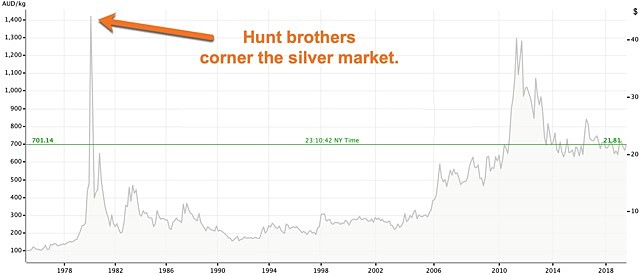Will silver soon benefit from gold’s bull run?

Silver may follow gold in a price rally of its own, although some analysts argue industrial demand will prevent this and widen the gold-silver ratio even further.
Silver could be the next metal to follow gold in its predicted bull run with some analysts believing it could even outperform gold in the near future.
Silver is up nearly 3% for the week, jumping a further 1.24% overnight to its current price of US$15.54 per ounce (A$22.14/oz).
This is the metal’s highest level in close to five months, after hitting US$16.02/oz in late February.
Historically, gold and silver have moved together in price, with gold generally moving first but silver rising or falling faster.
Known as the poor man’s gold, silver has traditionally benefitted from money spilling over into the commodity in the event of a rush on gold.
In recent months, gold has climbed to all-time highs, hovering above the US$1,400/oz (A$2,000/oz) mark for almost a month now.
Not only does silver traditionally lag behind, but it was also on a downward trend from its February high until late May.

The silver price is approaching a potential technical breakout.
In addition, gold-silver ratios have been the widest they have ever been, peaking at 93:1 earlier this month and currently around 90:1.
Now, silver seems to be picking back up.
Speaking with Small Caps, Martin Place Securities executive chairman Barry Dawes said he expects silver to “absolutely” follow in gold’s footsteps and thinks it will “very much outperform gold”.
“It’s pretty close to turning and when it does, it will run for at least two or three years, maybe longer,” he said.
Mr Dawes forecast silver to be above US$20/oz (A$28.5/oz) over the next 12 months and said it could possibly reach highs of around US$50/oz (A$71.25/oz) in “probably the next three to four years”.
This level has only been reached twice before – on Silver Thursday in 1980 after the Hunt brothers notoriously attempted to corner the silver market, and again briefly in 2011.
Mr Dawes also compared gold and silver to other precious metals, palladium and platinum, which have had a price flip in the last five years.
Platinum is currently US$838/oz while palladium is close to double at US$1,530.9/oz. But in 2015, platinum was up around US$1,450/oz while palladium was in the US$800s.
“Palladium’s just gone gang busters and when I think of palladium, I think of silver,” Mr Dawes said.
“What this means is that the possibility exists that there will be a major re-evaluation of silver against gold, purely on a supply/demand availability basis,” he said.
“There’s a great play there in silver – it’s still high risk, for all the reasons that small cap resources are, but once it turns, it will be very strong, I think,” he added.
The industrial metal argument
On the other side of the proverbial coin, some market experts have not been as bullish on silver as Mr Dawes.
According to INTL FCStone analyst Rhona O’Connell, weakening global economic growth is undermining the outlook for demand and dragging on prices. Adding to that, huge stockpiles could mean the metal is unlikely to join gold in its all-time highs.
Ms O’Connell told Reuters she could even see the gold-silver ratio touching 100:1.

The gold-silver ratio is now above 90:1.
Analysts at Canadian bank CIBC are just as sceptical of silver’s rally, saying they anticipate seeing the gold-silver ratio hover around 90:1, with long-term silver prices holding around US$16.50/oz.
Investment company Lion Selection Group’s (ASX: LSX) executive director Hedley Widdup says the argument revolves around silver now being seen more as an industrial metal and no longer a monetary metal that trends with gold to the same degree as it has traditionally.
“You might see some similar shapes from time to time with the trends, but you might be disappointed if you think that gold is up today, so silver should be up today or tomorrow,” he told Small Caps.
Not only is the price of silver partly dependent on industrial demand, it is also affected by pricing and supply/demand issues related to other commodities, since it tends to be a by-product of other mines such as zinc, lead and copper.
“As you get more production coming through the market of primary, then you get your secondary and your by-products increasing as well,” Mr Widdup said.
“The environment that we’re in, we certainly haven’t seen too many new projects introducing sources of supply, so I suspect that if you were just looking at supply and demand in the short-term, demand is likely to increase,” he added.
Mr Dawes agreed that silver relies on other mined resources.
“When the price of lead and zinc is low, we’ll find that production will decline and hence, the availability of silver will decline. And vice versa, when you get new mines coming on stream for lead and zinc, they increase the amount of silver into the market,” Mr Dawes said.
Mr Widdup also noted that silver tends to be capped by industrial demand, whereas gold could continue rising.
Although gold is not purely a precious metal and has some industrial uses, such as in dentistry and electronics, he said the supply and demand in these sectors do not tend to affect the price.
“If someone’s paying for a golden tooth implant, there are so many other substitutes you could use. Demand of gold in dentistry is not so great that it would move the price,” he said.
“Similarly, with things like electronics, gold is such a small value input to the final cost of the product that if you double the gold price, it doesn’t go anywhere near changing the price of the product to make it unaffordable,” Mr Widdup added.
“If silver were to double, I think you would see a very real industrial demand drop and for that reason you would probably see a price effect as well.”
“It might not be enough to drag it backwards, but it would certainly be enough to headbutt that ratio, so you’d be widening the gap between gold and silver,” Mr Widdup said.
Emotional investments
Another aspect Mr Widdup points out is that the physical buying and selling of gold is often guided by emotions, with many investors purchasing the metal for their own wealth stores rather than for a functional purpose.
He said there is no physical barrier to gold trading through US$1,300/oz, US$2,000/oz or above, because “at that level, it just becomes more valuable”.
Mr Widdup pointed to gold’s multiple bull runs from the late 1990s to 2010, saying the demand was driven by people wanting to buy it to get a phenomenal return.
“It wasn’t as if they were putting it to use, so there was no cost to them; it was just the price that they were paying,” he said.
Mr Widdup said in contrast, if you bought iron ore, which is consumed in steel making, there is a cost input that can be recovered on the other side by selling the steel.
“If the price of iron ore went up by 10 times in a very short period of time, the buyers of steel would start to push back on that; it would enclose a cap on the market”.
“With gold, that doesn’t exist, whereas with silver, I suspect that it probably does,” he said.
“Emotions of people wanting to buy gold can be very powerful in the way that they could push the price. If gold was to go up by US$50/oz, everybody says wow, there’s a rocket under the gold price, it’s worth getting on that.”
“It doesn’t suggest that because it’s going up it’s more likely to come back; it almost lends itself to [the theory that] because it’s going up, it’s likely to continue going up,” Mr Widdup said.
JP Morgan cornering the silver market
Another interesting aspect of silver’s recent price trend is the speculation that JP Morgan Chase may be trying to corner the silver market in a similar fashion as the Hunt brothers in 1980.
Data from the CME Group shows the investment bank by far holds the largest position in silver, with a total of 153.7 million troy ounces.
Well-known silver analyst Theodore Butler pointed out JP Morgan’s position two years ago, saying the bank had amassed a huge physical stockpile of silver “all while continuing to make hundreds of millions of dollars in manipulative COMEX short selling”.
Mr Butler was “convinced that silver will soon explode in price in a manner of unprecedented proportions, both in terms of previous silver rallies and relative to all other commodities”.
He added that he believed the silver price would exceed even the great price run ups in 1980 and 2011 to beyond US$50/oz.

The Hunt Brothers cornered the silver market in 1980, sending prices through the roof.
Late last year, one ex-JP Morgan trader pleaded guilty to fraudulently manipulating the precious metals markets from 2009 and 2015.
Four years previously, JP Morgan was sued by a lawyer on behalf of three traders who accused the bank of manipulating the silver futures market in 2010 and 2011, costing his clients $30 million in losses.
Mr Butler called out JP Morgan again this June, questioning why the bank seems to be “above the law”.
“Despite the guilty plea and announcement of an ongoing investigation, JP Morgan has continued to manipulate the price of silver and gold since the announcement, as well as continue to accumulate silver,” he said.
“I don’t think there could be a more significant market issue than JP Morgan’s manipulation of silver and gold and the only explanation for why so few see it is that they haven’t examined the public facts,” Mr Butler added.
